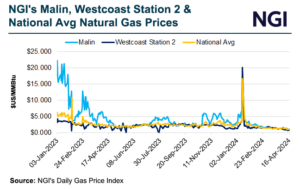E&P | NGI All News Access | NGI The Weekly Gas Market Report
U.S. Drilling Activity Steady Against Backdrop of Omicron Worries
© 2024 Natural Gas Intelligence. All rights reserved.
ISSN © 2577-9877 | ISSN © 1532-1266 | ISSN © 2158-8023 |

Natural Gas Prices
Natural gas production held near all-time highs through the first quarter in Canada, even as prices slumped following a mild winter that left supplies in storage at robust levels. That’s because producers are looking beyond near-term weakness and toward an anticipated jump in export demand, according to analysts. LNG Canada is slated to begin operations…
April 17, 2024Markets
By submitting my information, I agree to the Privacy Policy, Terms of Service and to receive offers and promotions from NGI.